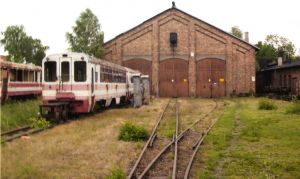Krosniewice

Krosniewice Engine Sheds 2009
Krosniewice is located 36 miles north-northeast of Lodz, Poland. German troops occupied Krosniewice on 16 September 1939. During the first days of the occupation, Jews were made to perform forced labour, some of them had property confiscated and many were expelled from their homes. Of the 4,476 inhabitants of the town, there were 1,238 Jews at the end of December 1939. This number included not only local Jews from the town itself, but also Jews from the surrounding area. Many Jews fled to Warsaw with the help of Polish guides.
On 10 May 1940, the German authorities established a ghetto in Krosniewice. It consisted of parts of Kurtnowska Street, which ran through the town in the direction of Kutno. The total area of the ghetto was 10,000 square meters. The ghetto was under the authority of the Mayor and also the head of the local civil administrator (Amtskommissar) Georg Becker. Initially the ghetto was not enclosed and sealed off, so the Jews were able to continue interacting with local Poles. Trade between them continued, with the Jews making handicrafts for the Poles, who paid them with food. Poles also consulted Jewish physicians residing in the ghetto. After a while, the ghetto was sealed with a barbed-wire fence and separated from the rest of the town. On the orders of the German authorities, a Jewish Council (Judenrat) was established in the ghetto, headed by a man named Zilbe; A Jewish Police was also established and it was headed by a man named Grabowski. Right from the start of the German occupation, the Jewish population was forced to undertake physically demanding work of all kinds. The Jewish community had to meet a quota of 66 workers per day, although some people who could not work, paid 5 zloty per day for a substitute. Jews were employed as workers on nearby farms, now belonging to newly resettled Germans from the Reich. In April 1941, about 100 residents of the ghetto were deported to the Hardt labour camp in Wasowo, near Poznan. They worked on the construction of the autobahn between Frankfurt am Oder and Poznan. Starting in September 1941, other ghetto residents, both men and women, were sent to other labour camps in the Poznan area. Those deported wrote letters to their relatives in the ghetto, describing the terrible conditions in the camps. Many residents tried to improve the lot of those who had been deported, by sending them packages of food and clothing.
On 19 February 1942, the German authorities demanded that a poll tax of 8 Reichsmark (RM) be paid for every resident of the ghetto. This was the signal for the beginning of the liquidation of the ghetto. On 1 March 1942, at the time of the Purim holiday, the women, children and elderly were threatened with deportation to Bessarabia, the next day. The liquidation of the ghetto took place on 2-3 March 1942. For this ‘Aktion’ some market halls where cattle were usually slaughtered were used as a transit camp for the Jews. In this temporary camp the people were given very poor rations. Twice a day the inmates received 2 pints of soup and a piece of bread. Most Jews were unable to eat this food because they did not have bowls.. From this temporary camp they were taken to the Chelmno death camp, where they were murdered in the gas-vans. During the liquidation ‘Aktion’ a member of the Jewish medical services named Kopel Geisler, who was also a member of the Krosniewice Zionist movement, became mentally unstable, watching the brutal way the Germans forced the Jews into the trucks for deportation. Altogether about 800 Jews from Krosniewice were killed at Chelmno. A report by the Amtskommissar in Krosniewice to the Mayor of Kutno on 10 April 1942, described the liquidation ‘Aktion’ as the ‘evacuation of those Jews unable to work.’ After the deportation of the residents of the ghetto, the value of the property they left behind, such as furniture, household goods and valuables was estimated at 25,000 RM, and all this property was transferred to the German authorities.
Sources:
The Encyclopaedia of Camps and Ghettos 1933-1945, USHMM, Indiana University Press Bloomington and Indianapolis 2012 Chelmno Witnesses Speak, The Council For the Protection of Memory of Combat and Martyrdom, The District Museum in Konin, Konin , Lodz 2004Photograph – Chris Webb Archive

